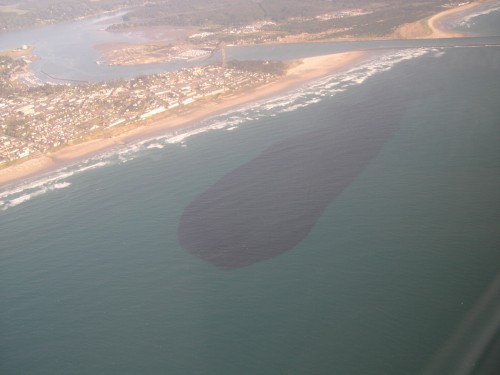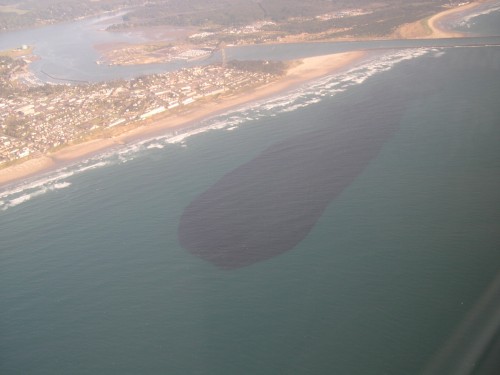
On Monday night, Oregon State University's Dr. Sarah Henkel presented findings on the City of Newport commissioned Ocean Bioaccumulation Survey of the Georgia Pacific Pulp Mill discharge. The survey report may have finally put to rest some long unanswered questions about the discharge's impact on the nearshore environment, where an average of 10-11 million gallons of the mill's wastewater is dumped daily within Newport's Nye Beach area. While the report may represent the final chapter in many years of work to improve the ocean outfall monitoring and eliminate certain wastestreams from the effluent, it also raises a few questions with respect to larger everyday and historical run-off and non-point sources of Newport and the surrounding area.

In the beginning...
Eight years ago when I started down this campaign journey with the Oregon chapter network I would have never imagined the twisting road of advocacy, research and outreach that would lead to where we are today. Admittedly, back in 2005, I didn't really want to take on the Georgia Pacific (GP) Pulp Mill campaign and cautioned our chapters to what would be likely an uphill battle with years of work. The chapters had already taken on the paper giant's permit 2 years previously and the Department of Environmental Quality (DEQ) had just reissued the permit without really adequately addressing any of the their concerns. In my book, it was exit time, the cards were stacked against them in a small community and DEQ had already reissued the permit.
Surfrider Files Petition with DEQ
Well, exiting wasn't really an option for the grassroots momentum that was fired up more than ever after the reissue of the permit. The chapters made a unanimous decision after the permit reissue to file a petition to reconsider the permit in 2006. Surfrider was contesting the permit with four primary concerns: a) environmental monitoring; b) no illegal waste streams; c) address flaws in modeling/ analysis; and d) compliance with turbidity and color standards. DEQ accepted the petition to reconsider the permit in late 2006, but then continued to sit on the permit reconsideration for the next two years. Everything sort of came to a screeching halt and being the creative bunch of ocean lovers they are, the chapters and activists started looking at other mechanisms to get DEQ to move on the reconsideration as well as alternate strategies for additional monitoring of the effluent.
Surfrider Develops Report to Aid DEQ
By March of 2008, Surfrider delivered a report with science-based recommendations for the permit to try and aid DEQ in the reconsideration process, given the lack of movement for 2 years by the agency. By May that year the agency finally moved to prioritize the issue, but not before local activists discovered yet another strategy to help support additional monitoring.
Seeking another Strategy for Monitoring
In early 2008 the Newport Chapter was able to uncover a long-expired license agreement between Georgia Pacific and the City of Newport that allowed GP to utilize the public right-of-way in Newport for their effluent lines. The chapter engaged in strong advocacy at city hearings to establish a new license agreement that funded local monitoring of the ocean discharge. After years of committees, task forces, proposal and study development, the license agreement ultimately supported the Ocean Bioaccumulation Survey that was presented on Monday night.
DEQ Reissues Permit with new Conditions
In March of 2009, one year following Surfrider's science-based recommendations and nearly 3 years following the original petition, DEQ finally reissued the GP permit with new conditions to address some of the monitoring and effluent discharge concerns. The permit was reissued with two new special conditions which no longer allowed inappropriate waste streams like Marion County leachate to be processed at the facility and required an Aquatic Community Survey. Throughout 2010, Surfrider volunteers worked closely with Georgia Pacific and CH2MHill (contracted for the aquatic community study) to survey the discharge area's sediment and water quality as well as species assemblages in comparison to reference areas outside of the impact of the discharge. The study completed in late 2010 addressing many of the questions and concerns for sediment and water, but not really addressing the greater questions of whether or not any toxic substance were accumulating in animals and organisms in the area (bioacummulation). For a nice re-cap of the study findings and everything above (including a little pulp mill history) check out this presentation.
Addressing the Monitoring Gap
Surfrider issued a report card on DEQ's reconsideration of the permit to help focus efforts for addressing gaps in monitoring. Citizens of Newport and Surfrider volunteers throughout 2011-2014 worked on several city task forces to review the Aquatic Community Survey required by the new permit and develop yet another study, funded through newly established license agreement dollars received from Georgia Pacific. Following a gap analysis process, bioaccumulation was identified as the number one priority for addressing questions and concerns from the citizens of Newport. After a lengthy process evaluating proposals for the study, the funding was awarded to Oregon State University's Dr. Sarah Henkel in cooperation with OSU's Heppell Lab. The survey was performed throughout 2012-2013 to collect various animals from within the pulp mill discharge area and compare concentrations of various substances toxic and otherwise with animals outside of the pulp mill discharge area. View a presentation summary of the findings, or check out the full report.
What We've Learned
Over the eight year course we've probably learned more about the collective and historical impacts to the nearshore environment that we all contribute to through run-off and non-point sources than any point source like the GP Pulp mill discharge. While none of the results demonstrate a concern for human health or reach toxicity values that are high enough to kill organisms, elevated levels of a myriad of toxins were detected at rates that can have an observed affect on organisms (this is known as a conservative toxicity reference value or TRV).
Both of the major studies performed demonstrate that the Georgia Pacific Pulp mill discharge area offshore has lower levels of contamination when compared to reference areas at South Beach and North Yaquina (see reports links above or at bottom for maps of reference areas). This applies to the sediment, the water and the toxins that we looked at in animals in these areas. We looked at organic compounds like PCBs, as well as PBDEs, phenols, trace metals and trace mercury. This wasn't the case when we looked at the intertidal areas where Nye Beach did have higher levels have higher levels of toxins exceeding conservative TRVs, however this cannot be solely attributed to the GP discharge due all the runoff and sewer issues we are all aware of in this same intertidal area.
One area of the studies that has been particularly concerning to our recreational audience was actually the elevated levels and concentrations of toxins found at South Beach, an extremely popular recreational area for our members. With the exception of intertidal, by an large this area is accumulating more toxins than the pulp mill's discharge area and the north Yaquina reference area. This was pretty consistent with the majority of thing we tested for in sediment, water and animals. None of the concentrations were at levels that could affect humans (yet), but certainly we found plenty of trace metals and toxins at South Beach exceeding conservative toxicity reference values, which means they are having some sort of impact on the environment and the animals that live there.
Where We've Come, Where We're Going
We've eliminated unnecessary and potentially harmful wastestreams like Marion County landfill leachate. We've accomplished an extensive amount of monitoring surveys to address the majority of questions and concerns that individuals have had with respect to the pulp mill's outfall and impact on the environment. More than anything we've established an excellent baseline for looking at these toxins and contaminants over the long run. This is extremely important as we continue to develop, urbanize or industrialize areas around Nye Beach and Newport, as we will be able to track by comparing future studies the impacts of these types of planning and resource-use decisions on our nearshore ocean environment. There is really no place in Oregon's nearshore ocean environment where we've collected such an extensive amount of ocean survey data.
From a campaign perspective, many of our goals have been accomplished with really just a couple of issues lingering for our chapters to evaluate where they stand and any future work. Sure the outfall discharge is ugly appearing as a dark plume in our nearshore, we never won any of the battles on this turbidity issue; but we did eliminate some wastestreams, answer a lot of questions with respect to what's in the discharge, whether its of concern to human health and whether or not it's causing noticeable changes to the ocean environment compared to a couple of nearby reference areas. In the coming months, our chapters will be further evaluating this campaign, but for now...a lot of history to chew on.
Full Reports and Supporting Documents For Reference
Aquatic Community Survey and Permit History - Presentation Summary
Ocean Bioaccumulation Survey - Presentation Summary
Ocean Bioaccumulation Survey - Full Report
Surfrider Science Recommendations Report - 2008
Original Petition for Permit Reconsideration - 2006
